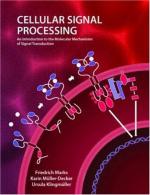|
This section contains 382 words (approx. 2 pages at 300 words per page) |
Transduction is defined as the transfer of genetic information between cells using a type of virus particle called a bacteriophage. The virus contains genetic material from one cell, which is introduced into the other cell upon virus infection of the second cell. Transduction does not, therefore, require cell to cell contact and is resistant to enzymes that can degrade DNA.
Bacteriophage can infect the recipient cell and commandeer the host's replication machinery to produce more copies of itself. This is referred to as the lytic cycle. Alternatively, the phage genetic material can integrate into the host DNA where it can replicate undetected along with the host until such time as an activation signal stimulates the production of new virus particles. This is referred to as the lysogenic cycle. Transduction relies on the establishment of the lysogenic cycle, with the bacterial DNA becoming incorporated into the recipient cell chromosome along with the phage DNA. This means of transferring bacteria DNA has been exploited for genetic research with bacteria like Escherichia coli, Salmonella typhimurium, and Bacillus subtilis, which are specifically targeted by certain types of bacteriophage.
There are two types of transduction: generalized transduction and specialized transduction. In generalized transduction, the packaging of bacterial DNA inside the phage particle that subsequently infects another bacterial cell occurs due to error. The error rate is about one phage particle in 1,000. Experimental mutants of phage have been engineered where the error rate is higher. Once the bacterial DNA has been injected inside the second bacterium, there is approximately a 10percent change that the DNA will be stably incorporated into the chromosome of the recipient. A successful integration changes the genotype and phenotype of the recipient, which is called a transductant. A transductant will arise for about every 106 phage particles that contain bacterial DNA.
Specialized transduction utilizes specialized phage, in which some of the phage genetic material has been replaced by other genetic material, typically the bacterial chromosome. All of the phage particles carry the same portion of the bacterial chromosome. The phage can introduce their DNA into the recipient bacterium as above or via recombination between the chromosomal DNA carried by the phage and the chromosome itself.
Transduction has proved to be a useful means of transferring genetic traits from one bacterial cell to another.
|
This section contains 382 words (approx. 2 pages at 300 words per page) |


